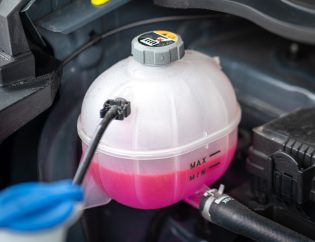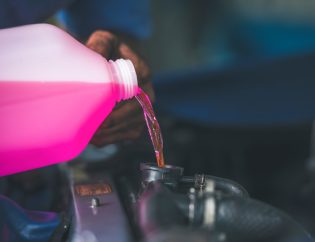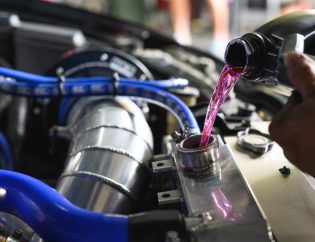
The symptoms of insufficient coolant range from inconvenient to catastrophic. In this article by Azure Chemical, we’ll explore what happens when coolant runs too low, how to detect and remedy the issue, and how to keep your coolant where it needs to be.
Contents
Overheating Engine
The coolant, also known as antifreeze, is a liquid that helps regulate your engine’s temperature. As fuel combusts in the engine, a tremendous amount of heat is generated.
This heat can increase quickly to temperatures that can harm metal engine components if an adequate cooling system isn’t in place.
The coolant absorbs this excess heat and circulates through the radiator. The heat is released into the outside air as it passes through the radiator. This cools the coolant to recirculate through the engine and absorb more heat.
When coolant levels get too low, its heat-absorbing properties decrease. This allows engine temperatures to climb unchecked. Prolonged overheating can warp cylinder heads, cause gaskets to fail, or crack the engine block. Overheated engines risk catastrophic failure, where they seize up entirely.
One of the most common failures is a blown head gasket. The space between the cylinder head and engine block is sealed by the head gasket. It is designed to withstand tremendous pressures and heat. However, excessively high temperatures can cause the gasket to warp, burn, or create small cracks. This allows combustion gases to escape into the coolant or engine oil. A blown head gasket usually requires extensive engine repairs.
Maintaining proper coolant levels is crucial to protect your engine from overheating damage. Even minor coolant losses should be addressed immediately. Letting your engine run hot for short periods can initiate head gasket failure or other serious problems.
Coolant Leaks
One of the first signs of low engine coolant is external coolant leaks. Coolant leaks indicate that the cooling system has been compromised, allowing the fluid to escape.

Some common places where coolant leaks can occur include:
Radiator
Cracks or damage in the radiator can cause coolant to leak out. The radiator is responsible for cooling the fluid, so leaks here can quickly result in overheating.
Hoses
The rubber hoses circulating engine coolant can become worn out or cracked over time. This allows coolant to drip or spray out.
Water pump
A bad water pump seal will leak coolant. The water pump circulates the fluid through the engine.
Reservoir tank
Cracks in the plastic reservoir tank can cause leaks. The tank holds extra coolant to top off the system.
Freeze plugs
Corrosion of the freeze plugs placed in the engine block can lead to leaks. Freeze plugs can pop out under pressure.
Head gasket
A blown or damaged head gasket prevents a proper seal and allows coolant to leak into the cylinders or oil.
Observing for coolant pooling under the car or spray marks on components can help identify external leaks. Addressing any leaks quickly is important to prevent larger problems.
Engine Damage
Driving with low coolant can lead to severe engine damage. When the coolant level gets too low, it can’t properly regulate the engine’s temperature. This leads to overheating, which can crack cylinder heads and warp valves and cause head gasket leaks.
Cracked cylinder heads are one of the most serious consequences of overheating due to low coolant. The extreme heat causes the metal in the cylinder heads to expand rapidly. This expanding metal can crack the head and render the engine unusable. Replacing a cracked cylinder head is very expensive.
Overheating also commonly leads to warped valves. The valves get so hot they can warp and no longer seat properly. This reduces compression and causes poor engine performance. Warped valves require a full cylinder head rebuild or replacement.
Head gasket failure is another common engine damage from low coolant. Head gaskets seal the gap between the cylinder heads and the engine block. When the engine overheats, the head gasket material gets burnt and degraded. This mixes coolant and oil, leading to serious mechanical issues. A leaking head gasket requires immediate repair to prevent further damage.
Low coolant levels put your engine at high risk of overheating damage. Cracked heads, warped valves, and blown head gaskets all require major engine work costing thousands of dollars. Monitoring coolant and fixing leaks quickly is crucial to avoid catastrophic engine failure.
Overheating Transmission
The transmission relies on coolant to regulate its temperature.

Coolant flows from the radiator through lines to the transmission to keep it from overheating. If the coolant level is low, the transmission fluid will not be properly cooled. This can lead to overheating issues within the transmission.
Overheating causes transmission fluid to break down. The fluid then loses its lubricating properties, increasing friction and wear on internal transmission components. If the overheating persists, it can eventually lead to complete transmission failure. Seals can crack or leak, clutches and bands can slip and fail, and gears can grind or break. A vehicle with a failed transmission cannot shift gears or go into gear.
It’s critical to address low coolant levels promptly before overheating damages the transmission. Monitoring coolant levels and fixing any leaks is key to preventing costly transmission repairs down the road. Drivers should never ignore a low coolant warning light or temperature gauge reading.
AC Failure
A vehicle’s air conditioning (AC) system relies on the engine cooling system to function properly. The engine drives the AC compressor, while the AC condenser cools the refrigerant after it leaves the compressor. The condenser needs a constant flow of coolant from the radiator to work effectively.
When coolant levels run low, it can prevent the AC condenser from cooling the refrigerant as required. This leads to reduced cooling capacity from the AC system. You may notice the air coming out of the vents should be warmer. In extreme cases of coolant loss, the AC may stop blowing cold air altogether.
The condenser depends on coolant, just like the engine itself. Low coolant starves the condenser of the liquid it needs to exchange heat. The system can produce cold air for cabin co on hot days with proper condenser operation. Keeping the coolant level topped off is crucial for avoiding AC failure when refrigerant levels are adequate. Monitor coolant levels and fix leaks promptly to ensure sufficient coolant flow for AC condenser functioning.
Heater Issues
When the engine coolant level gets too low, it can prevent your car’s heater from working properly.
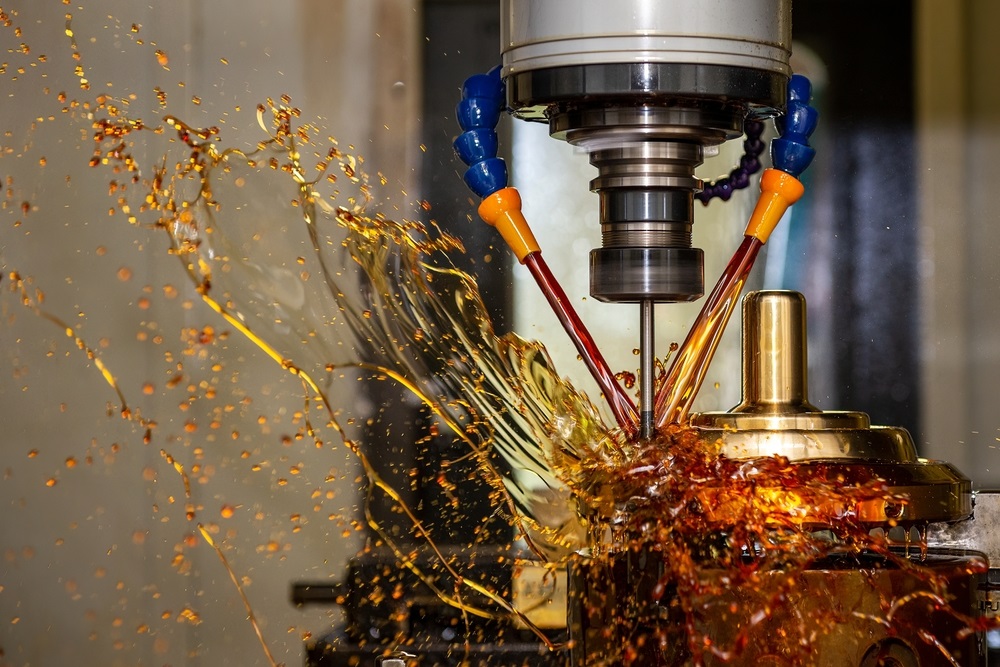
This is because the heater core relies on hot coolant from the engine circulating through it to warm up the air blown into the cabin.
The heater core will only get hot enough to provide sufficient heat with enough coolant. A lack of heat from your car’s heater when it’s cold outside is one of the main signs that the coolant level may be too low.
Even with the temperature set too high, little or no warm air will come out of the vents if the coolant is low. This is a clear indicator of low coolant rather than a faulty heater core itself. Topping the coolant level will resolve any heating problems caused by insufficient coolant reaching the heater core.
Checking Coolant Level
Regularly checking your coolant level to help prevent overheating issues is important.
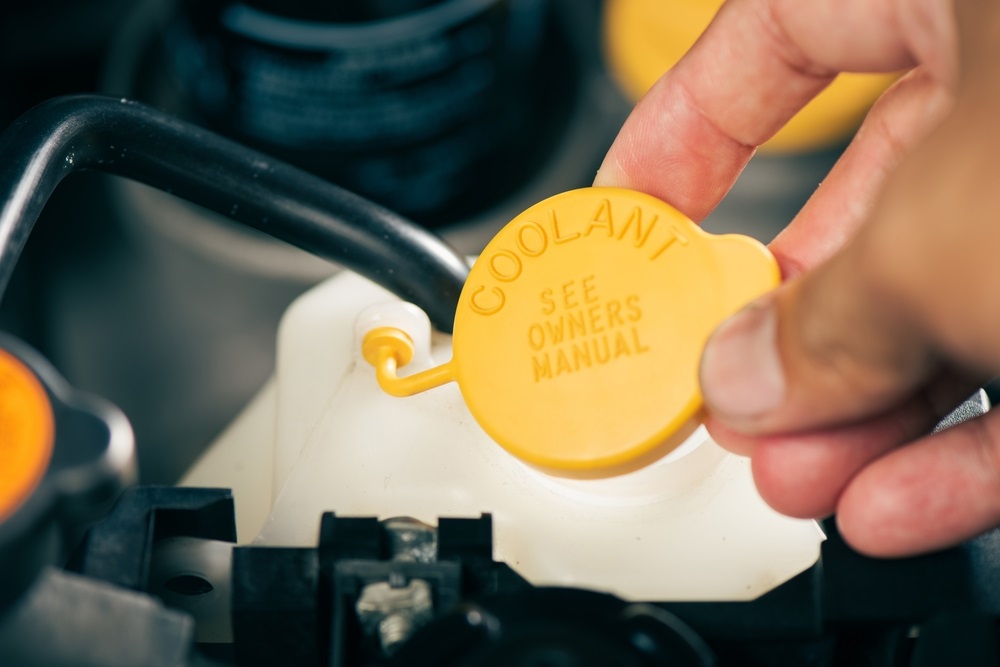
Here’s how to safely check it:
- Wait for the engine to fully cool – never remove the radiator cap when it’s hot. Scalding steam and fluid can shoot out under pressure and cause severe burns.
- Locate the coolant reservoir, usually next to the radiator, with minimum and maximum marks on the side. The level should be between the two marks when cold.
- If it’s low, carefully add a 50/50 mix of coolant and distilled water to bring it up to the maximum mark. Avoid overflowing.
- White smoke from the tailpipe can indicate a coolant leak into the combustion chambers. Topping up without fixing the leak could lead to engine damage.
Coolant should be flushed and replaced every 2-3 years. It degrades over time and loses its ability to prevent corrosion. Use the type recommended in your owner’s manual.
Checking it regularly and maintaining proper levels is the best way to avoid overheating and associated engine damage from low coolant.
Fixing Low Coolant
If you’ve identified that your vehicle has low coolant, you’ll need to fix the issue before driving the vehicle further to avoid engine damage.
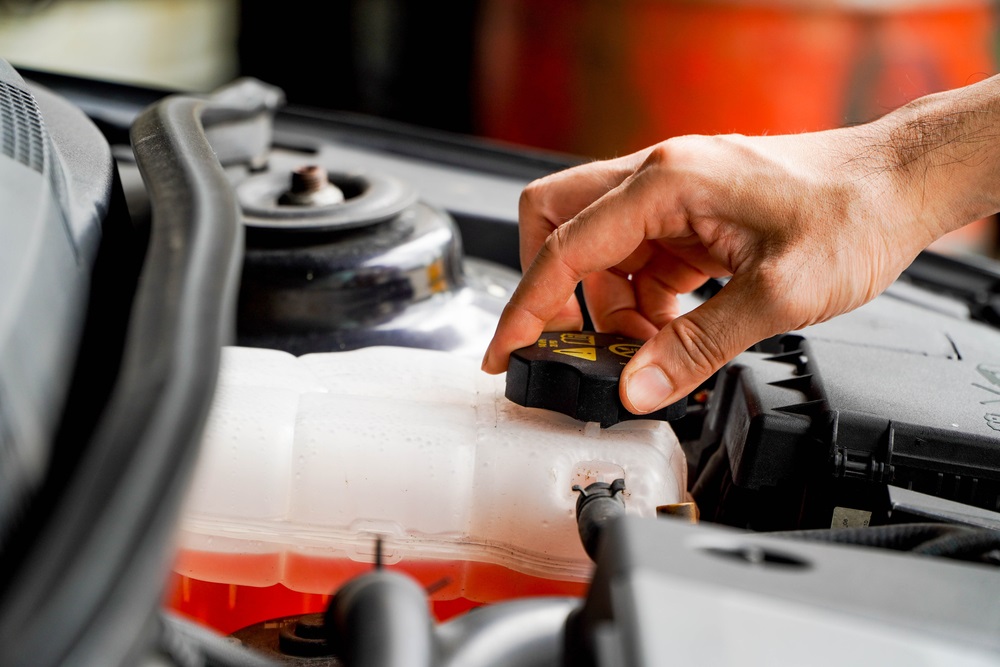
Here are the steps for fixing low coolant.
Identify and Fix Any Leaks
The first step is to check for any leaks that may be causing the low coolant levels.
Look along all coolant hoses and connections for any dripping or wetness.
Also, look around the water pump, radiator, heater core, and engine block for signs of leaking.
Any leaks must be properly repaired, which may require replacing hoses, gaskets, or other components.
Refill the Coolant
Once any leaks have been fixed, you’ll need to refill the coolant system. Utilize the coolant that the manufacturer of your car has advised—it’s typically mentioned in the owner’s manual. Mix the coolant with distilled water to obtain the proper 50/50 ratio. Carefully pour the coolant into the radiator until it’s filled up. You may need to squeeze or loosen the hoses while pouring to allow trapped air to escape.
Bleed Air from the System
It’s crucial to bleed out any air trapped in the coolant system. Air pockets can cause overheating issues.
To bleed the system, carefully pour coolant into the radiator with the cap off and start the engine with the heater on max. Let the vehicle idle and continue adding coolant to the radiator as needed. Watch for bubbles as the air escapes from the system. Repeat until no more bubbles are seen, then replace the radiator cap.
The low coolant issue should be resolved once the system is properly refilled with new coolant and all air is bled out. Check levels again after a few days of driving to top off if needed. Proper coolant maintenance helps ensure your engine stays running cool.
FAQ
Here are the most asked questions:
What Is Coolant and Why Is It Important for My Car?
Coolant, also known as antifreeze, is a fluid used in cars to regulate the engine’s temperature. It prevents the engine from overheating in hot conditions and freezing in cold conditions, ensuring optimal performance.
How Can I Tell If My Car Has Low Coolant?
Signs of low coolant include the engine overheating warning light on your dashboard, a rising temperature gauge, and possibly a sweet smell (which is the scent of the coolant).
What Are the Risks of Driving with Low Coolant?
Driving with low coolant can lead to engine overheating, which can cause severe damage such as warped cylinders, damaged head gaskets, and in extreme cases, complete engine failure.
Can Low Coolant Affect My Car’s Heating System?
Yes, low coolant can result in poor heating performance inside the car because the heat exchanger, which provides warm air, relies on hot coolant from the engine.
Conclusion
Having adequate coolant is crucial to prevent engine overheating and damage. Here are some tips to help prevent low-coolant issues:
- Check your coolant level regularly. Your owner’s manual will specify how often you should check it, but once a month is a good rule of thumb. The coolant reservoir will have markings indicating if the level is low.
- Replace the coolant at the intervals specified by the manufacturer of your car, which is often every two to five years. Over time, coolant degrades and becomes less effective. Changing it in accordance with the maintenance plan will maintain the system’s appropriate security.
- Deal with leaks as soon as possible. Radiator leaks are frequently caused by leaks in the hoses, water pump, heater core, and head gasket. If you smell coolant inside your car or see it on the ground, get your car checked out. Major engine damage is less likely to happen the faster a leak is fixed.
- Use the coolant recommended for your car. To find out what kind of coolant your engine needs, consult your owner’s manual. Corrosion and blockages might result from using the incorrect coolant.
Taking simple preventive measures can save you from very costly engine repairs down the road. Monitoring coolant levels, changing it regularly, and fixing any leaks promptly will help avoid the serious consequences of low coolant. Learn more about the different kinds of antifreeze and coolant by contacting us today.


